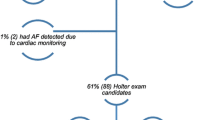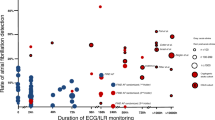Abstract
Objectives
Atrial cardiopathy (AC) is more frequent in patients with embolic stroke of undetermined source (ESUS) than in patients with non-cardioembolic stroke. The aim of this work was to describe AC in patients with ESUS and to study its impact on detection of atrial fibrillation (AF) during follow-up.
Methods
This is an observational study of 123 consecutive ESUS patients and 55 ESUS patients from a previous cohort. AC was defined according to the presence of one or more of the following criteria: severe left atrial enlargement, p-wave terminal force in lead V1 > 5000 μVxms, and excessive premature atrial complexes. Unadjusted and adjusted survival analyses for the occurrence of AF and stroke or transient ischemic attack (TIA) were performed. Diagnostic performance of AC for the detection of AF was analyzed.
Results
Among 178 patients with ESUS, those with AC (42.7%) were older (p < 0.001), and more frequently had hypertension (p = 0.001) and lower total cholesterol levels (p = 0.001) than patients without AC. The detection of AF during follow-up (median 34 months, interquartile range = 12.8–64) was higher in patients with AC (hazard ratio = 7.00, 95% confidence interval = 2.01–24.39, p = 0.002). This association persisted after adjusting for age, arterial hypertension, and other vascular risk factors. The c-statistic for detection of AF during follow-up for AC was 0.719. There were no differences in stroke or TIA recurrence between groups with and without AC.
Discussion
ESUS patients with AC have different baseline clinical characteristics than patients without AC and have a higher detection of AF during follow-up.

Similar content being viewed by others
Availability of data and material
The data supporting the findings of this study are available upon reasonable request.
Code availability
Not applicable.
References
Hart RG, Catanese L, Perera KS et al (2017) Embolic stroke of undetermined source: a systematic review and clinical update. Stroke 48:867–872
Hart RG, Diener HC, Coutts SB et al (2014) Embolic strokes of undetermined source: the case for a new clinical construct. Lancet Neurol 13:429–438
Kamel H, Bartz TM, Elkind MSV et al (2018) Atrial cardiopathy and the risk of ischemic stroke in the CHS (Cardiovascular Health Study). Stroke 49:980–986
Kamel H, Okin PM, Elkind MSV et al (2016) Atrial fibrillation and mechanisms of stroke: time for a new model. Stroke 47:895–900
Jalini S, Rajalingam R, Nisenbaum R et al (2019) Atrial cardiopathy in patients with embolic strokes of unknown source and other stroke etiologies. Neurology 92:288–294
Pinho J, Braga CG, Rocha S et al (2015) Atrial ectopic activity in cryptogenic ischemic stroke and TIA: A risk factor for recurrence. J Stroke Cerebrovasc Dis 24:507–510
Diener HC, Sacco RL, Easton JD et al (2019) Dabigatran for prevention of stroke after embolic stroke of undetermined source. N Engl J Med 380:1906–1917
Hart RG, Sharma M, Mundl H et al (2018) Rivaroxaban for stroke prevention after emboli stroke of undetermined source. N Engl J Med 378:2191–2201
Kamel H, Merkler AE, Iadecola C et al (2019) Tailoring the approach of embolic stroke of undetermined source: a review. JAMA Neurol 76:855–861
Smietana J, Plitt A, Halperin JL (2019) Thromboembolism in the absence of atrial fibrillation. Am J Cardiol 124:303–311
Healey JS, Gladstone DJ, Swaminathan B et al (2019) Recurrent stroke with rivaroxaban compared with aspirin according to predictors of atrial fibrillation: secondary analysis of the NAVIGATE ESUS randomized clinical trial. JAMA Neurol 76:764–773
Kamel H, Jr WTL, Tirschwell DL, et al. (2018) The atrial cardiopathy and antithrombotic drugs in prevention after cryptogenic stroke randomized trial : rationale and methods. 14:207-214
Perlepe K, Sirimarco G, Strambo D et al (2020) Left atrial diameter thresholds and new incident atrial fibrillation in embolic stroke of undetermined source. Eur J Intern Med 75:30–34
Elkind MS (2018) Atrial cardiopathy and stroke prevention. Current cardiology reports 20(11):1-14.15
Rasmussen SMA, Olsen FJ, Jørgensen PG, Fritz-Hansen T, Jespersen T, Gislason G, Biering-Sørensen T (2019) Utility of left atrial strain for predicting atrial fibrillation following ischemic stroke. Int J Cardiovasc Imaging 35(9):1605–1613
Author information
Authors and Affiliations
Corresponding author
Ethics declarations
Ethical approval
The study was approved by the local health ethics committee (ref. 40/2019).
Conflict of interest
None.
Additional information
Publisher's Note
Springer Nature remains neutral with regard to jurisdictional claims in published maps and institutional affiliations.
Rights and permissions
About this article
Cite this article
Silva, A.R., Pires, C., Meira-Carvalho, F. et al. Atrial cardiopathy predicts detection of atrial fibrillation in embolic stroke of undetermined source: real-life data. Neurol Sci 43, 2383–2386 (2022). https://doi.org/10.1007/s10072-021-05692-3
Received:
Accepted:
Published:
Issue Date:
DOI: https://doi.org/10.1007/s10072-021-05692-3




